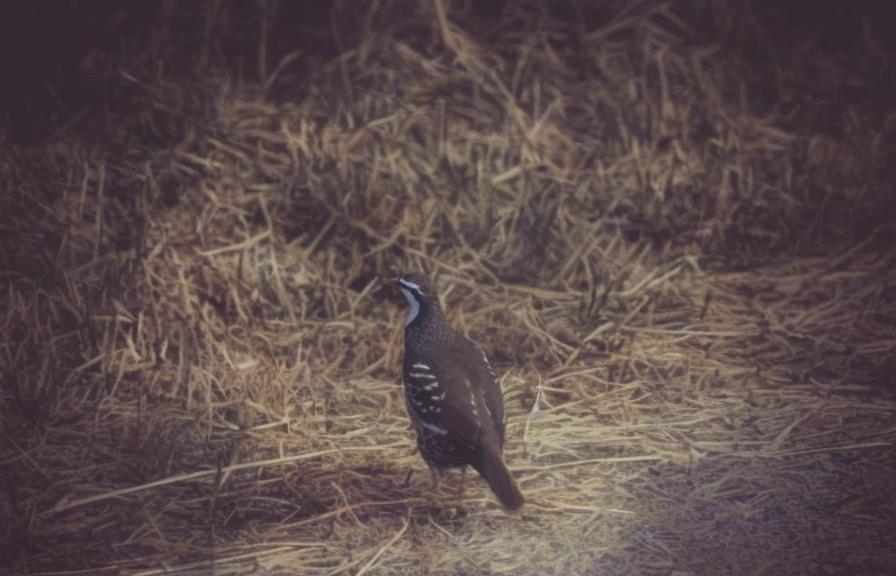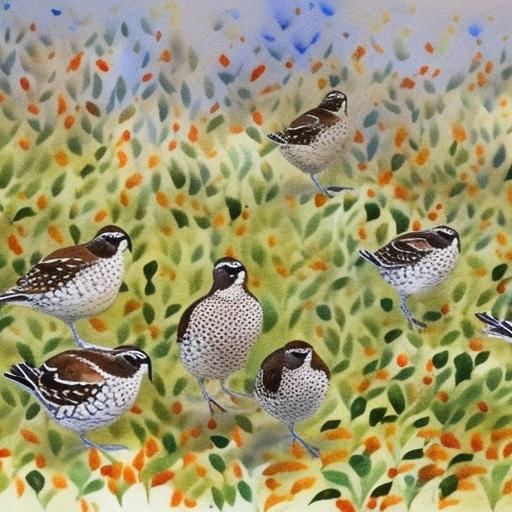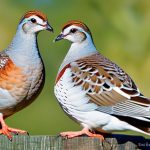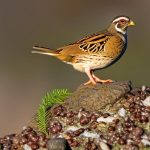Line breeding is a selective breeding technique used to concentrate desirable traits within a population of quail. This is achieved by breeding closely related individuals, such as siblings or parent-offspring pairs, over several generations. The goal of line breeding is to fix specific genetic traits within a population, leading to a more uniform and predictable offspring. This can be particularly useful in quail breeding, where traits such as size, egg production, and disease resistance are highly valued.
In line breeding, the breeder carefully selects individuals with the desired traits and mates them to produce offspring with an even stronger expression of those traits. Over time, this can lead to a population of quail that consistently exhibits the desired characteristics. However, it is important to note that line breeding can also increase the expression of undesirable traits, such as genetic disorders or reduced fertility. Therefore, it requires careful management and monitoring to ensure the overall health and welfare of the quail population.
Key Takeaways
- Line breeding in quail involves breeding closely related individuals to maintain desirable traits
- Potential risks of line breeding include increased expression of genetic disorders and reduced fertility
- Line breeding can lead to decreased genetic diversity within a population
- Health and welfare concerns in line breeding include higher susceptibility to diseases and reduced overall fitness
- Ethical considerations in line breeding involve balancing genetic improvement with animal welfare and avoiding unnecessary suffering
- Alternatives to line breeding include outcrossing with unrelated individuals and utilizing genetic selection techniques
- Balancing genetic improvement and welfare is crucial in line breeding to ensure the long-term health and sustainability of quail populations
Potential Risks of Line Breeding
While line breeding can be an effective tool for genetic improvement in quail, it also comes with potential risks. One of the main concerns with line breeding is the increased likelihood of genetic disorders and inherited diseases. When closely related individuals are bred together over multiple generations, there is a higher chance of recessive genetic traits being expressed. This can lead to a higher incidence of health issues within the population, such as skeletal deformities, immune system deficiencies, or reproductive problems.
Another risk of line breeding is the reduction of genetic diversity within the quail population. As closely related individuals are repeatedly bred together, the gene pool becomes more limited, leading to a loss of genetic variation. This can make the population more vulnerable to environmental changes, diseases, and other external pressures. Additionally, inbreeding depression can occur, resulting in decreased fertility, lower hatch rates, and overall reduced fitness in the quail population.
Impact on Genetic Diversity
Line breeding can have a significant impact on the genetic diversity of quail populations. By repeatedly mating closely related individuals, the gene pool becomes more restricted, leading to a decrease in genetic variation. This can have long-term consequences for the overall health and adaptability of the quail population. Reduced genetic diversity can make the population more susceptible to diseases and environmental stressors, as there are fewer genetic resources to draw upon for survival and adaptation.
Furthermore, decreased genetic diversity can also limit the potential for future genetic improvement within the quail population. With a smaller gene pool, there are fewer opportunities for new combinations of genes to arise, potentially hindering the development of new desirable traits. This can ultimately limit the ability of quail breeders to respond to changing market demands or environmental challenges. Therefore, it is important for breeders to carefully consider the impact of line breeding on genetic diversity and take steps to mitigate any negative effects.
Health and Welfare Concerns
Line breeding can raise significant health and welfare concerns for quail populations. As closely related individuals are bred together over multiple generations, there is an increased risk of genetic disorders and inherited diseases. This can lead to suffering and reduced quality of life for the quail, as well as increased management challenges for breeders. Genetic disorders such as skeletal deformities or immune system deficiencies can impact the overall welfare of the quail population, leading to decreased productivity and increased susceptibility to stress and disease.
In addition to health concerns, line breeding can also raise welfare issues related to inbreeding depression. As genetic diversity decreases within the population, there is a higher likelihood of reduced fertility, lower hatch rates, and overall decreased fitness in the quail. This can lead to increased mortality rates and decreased overall well-being for the birds. Therefore, it is crucial for breeders to prioritize the health and welfare of their quail populations when considering line breeding as a genetic improvement strategy.
Ethical Considerations
The use of line breeding in quail populations raises important ethical considerations for breeders and animal welfare advocates. Breeding closely related individuals over multiple generations can lead to an increased risk of genetic disorders and inherited diseases within the population. This raises questions about the ethical implications of knowingly perpetuating suffering and reduced quality of life for the quail. Additionally, concerns about inbreeding depression and decreased fitness in the population raise further ethical questions about the impact of line breeding on the overall well-being of the birds.
Furthermore, there are ethical considerations related to the potential loss of genetic diversity within quail populations as a result of line breeding. Decreased genetic variation can limit the ability of quail populations to adapt to changing environmental conditions and may ultimately compromise their long-term survival. This raises questions about the responsibility of breeders to prioritize the preservation of genetic diversity and overall welfare of their quail populations when making breeding decisions.
Alternatives to Line Breeding

In light of the potential risks and ethical considerations associated with line breeding in quail populations, it is important for breeders to consider alternative genetic improvement strategies. One alternative approach is outcrossing, which involves mating individuals from different genetic lines to introduce new genetic variation into the population. Outcrossing can help mitigate the negative effects of inbreeding and increase genetic diversity within the quail population, leading to improved overall health and adaptability.
Another alternative to line breeding is the use of selective breeding based on performance traits rather than relatedness. By focusing on specific performance traits such as egg production or disease resistance, breeders can achieve genetic improvement without relying on closely related individuals. This approach can help maintain genetic diversity within the population while still achieving desired breeding goals. Additionally, incorporating genomic selection techniques can further enhance the precision and efficiency of selective breeding efforts in quail populations.
Balancing Genetic Improvement and Welfare
In conclusion, line breeding is a selective breeding technique that can be used to concentrate desirable traits within quail populations. However, it comes with potential risks related to genetic disorders, reduced fertility, and decreased genetic diversity. These risks raise important health, welfare, and ethical considerations for breeders and animal welfare advocates. It is crucial for breeders to carefully consider these factors when making breeding decisions and to prioritize the overall well-being of their quail populations.
By exploring alternative genetic improvement strategies such as outcrossing and selective breeding based on performance traits, breeders can achieve their breeding goals while maintaining genetic diversity and promoting the health and welfare of their quail populations. Ultimately, finding a balance between genetic improvement and welfare considerations is essential for ensuring the long-term sustainability and well-being of quail populations in captivity.
Line breeding in quail can have detrimental effects on the overall health and genetic diversity of the population. To learn more about the importance of genetic diversity in poultry breeding, check out this insightful article on the incubation period for goose eggs. Understanding the impact of breeding practices on genetic diversity is crucial for maintaining healthy and sustainable poultry populations.
FAQs
What is line breeding in quail?
Line breeding in quail is a breeding method where closely related individuals, such as siblings or parent-offspring pairs, are mated to maintain or reinforce specific desirable traits within a population.
What are the potential drawbacks of line breeding in quail?
Line breeding in quail can lead to an increase in the expression of deleterious recessive genes, which may result in reduced overall fitness, increased susceptibility to diseases, and decreased reproductive success.
How does line breeding affect genetic diversity in quail populations?
Line breeding in quail can lead to a decrease in genetic diversity within a population, as it involves repeated mating of closely related individuals. This reduction in genetic diversity can make the population more vulnerable to environmental changes and disease outbreaks.
Are there any potential benefits of line breeding in quail?
Line breeding in quail can be used to fix specific desirable traits within a population, such as plumage color or egg production. However, it is important to carefully manage line breeding to minimize the negative effects on genetic diversity and overall fitness of the population.
Meet Walter, the feathered-friend fanatic of Florida! Nestled in the sunshine state, Walter struts through life with his feathered companions, clucking his way to happiness. With a coop that’s fancier than a five-star hotel, he’s the Don Juan of the chicken world. When he’s not teaching his hens to do the cha-cha, you’ll find him in a heated debate with his prized rooster, Sir Clucks-a-Lot. Walter’s poultry passion is no yolk; he’s the sunny-side-up guy you never knew you needed in your flock of friends!







